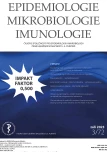Detekce superantigenů u izolátů Streptococcus pyogenes na základě dat celogenomové sekvenace
Authors:
R. Veselá 1
; S. Vohrnová 1,2
; J. Kozáková 1
Authors‘ workplace:
Státní zdravotní ústav, Centrum epidemiologie a mikrobiologie, Národní referenční laboratoř pro streptokokové nákazy
1; 3. lékařská fakulta Univerzity Karlovy, Praha
2
Published in:
Epidemiol. Mikrobiol. Imunol. 72, 2023, č. 3, s. 191-194
Category:
Short Communication
Overview
Streptococcus pyogenes causes a variety of human diseases ranging from uncomplicated respiratory tract and skin infections to severe invasive diseases possibly involving toxic shock syndrome. Besides the emm gene-encoded M protein, important virulence factors are pyrogenic exotoxins, referred to as superantigens. The National Reference Laboratory for Streptococcal Infections has newly introduced bioinformatics tools for processing S. pyogenes whole genome sequencing data. Using the SRST2 software and BV-BRC platform, WGS data of 10 S. pyogenes isolates from patients with invasive disease were analysed, and emm type, sequence type, and superantigen encoding gene profiles were determined. The Unicycler assembly pipeline with the SPAdes de novo assembler was used to assemble genome sequences from short reads.
Keywords:
whole genome sequencing – Streptococcus pyogenes – GAS – superantigen
Sources
- Holm SE. Invasive group A streptococal infections. The New England Journal of Medicine, 1996;335 : 590–591.
- Imohl M, Fitzner Ch, Perniciaro S, et al. Epidemiology and distribution of 10 superantigens among invasive Streptococcus pyogenes disease in Germany from 2009 to 2014. Plos One, 2017;12(7):e0180757. doi: 10.1371/journal.pone.0180757.
- Lintges M, Arlt S, Uciechowski P, et al. A new closed-tube multiplex real-time PCR to detect eleven superantigens od Streptococcus pyogenes dentifies a strain without superantigen aktivity. International Journal of Medical Microbiology, 2007;297 : 471–475.
- Inouye M, Dashnow H, Raven LA, et al. SRST2. Rapid genomic surveillance for public health and hospital mikrobiology labs. Genome Medicine, 2014;6(90). doi:10.1186/s13073-014-0090-6.
- Liu B, Zheng D, Zhou S, et al. VFDB 2022: a general classification scheme for bacterial virulence factors. Nucleic Acid Research, 2022;50(D1):D912–D917.
- Jolley KA, Bray JE, Maiden MCJ. Open-access bacterial population genomics: BIGSdb software, the PubMLST.org website and their applications. Wellcome Open Res, 2018;3 : 124. doi: 10.12688/wellcomeopenres.14826.1.
- Olson RD, Assaf R, Brettin T, et al. Introducing the Bacterial and Viral Bioinformatics Resource Center (BV-BRC: a resource combining PATRIC, IRD and ViPR. Nucleic Acids Research, 2023;51(D1):D678–D689.
- Sayers S, Li L, Ong E, et al. Victors: a web-based knowledge base of virulence factors in human and animal pathogens. Nucleic Acids Researchs, 2019;47(D1):D693–D700.
- Wick RR, Judd LM, Gorrie CL, et al. Unicycler: resolving bacteria genome assemblies from short and long sequencing reads. PloS Computational Biology, 2017;13(6):e1005595. doi: 10.1371/journal.pcbi.1005595.
- Bankevich A, Nurk S, Antipov D, et al. SPAdes: a new genome assembly algorithm and its applications to single-cell sequencing. Journal of Computational Biology, 2012;19(5):455–477.
- Jolley KA, Maiden MCJ. BIGSdb: Scalable analysis of bacterial genome variation at the population level. BMC Bioinformatics, 2010;11(1). doi: 10.1186/1471-2105-11-595.
Labels
Hygiene and epidemiology Medical virology Clinical microbiologyArticle was published in
Epidemiology, Microbiology, Immunology

2023 Issue 3
Most read in this issue
- Mykobakteriózy – nejčastější původci
- Lidská babesióza
- Nárůst prevalence celiakie – kde hledat odpovědi?
- Extracelulární vezikuly v infekčním lékařství – význam a perspektivy
